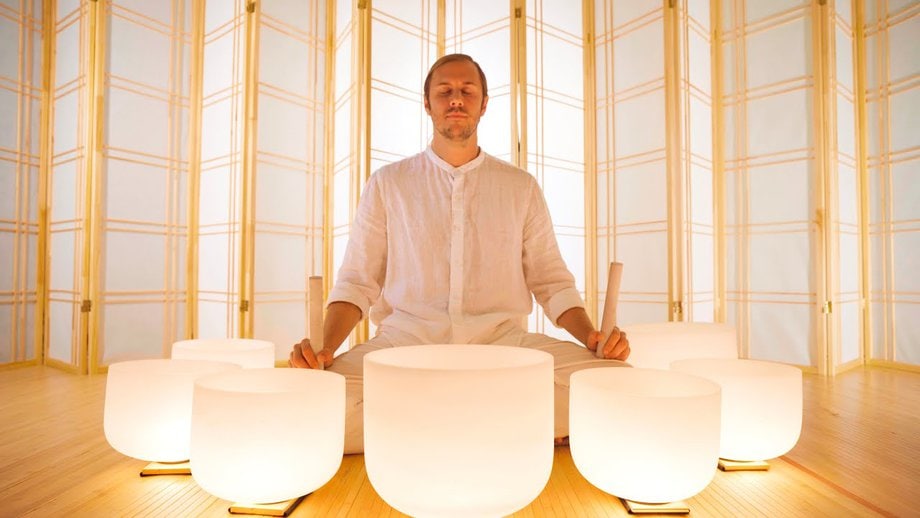Enhancing Mindfulness Through Sound Bath Meditation

Are you looking to enhance your mindfulness practice? Discover the transformative benefits of sound bath meditation.
In this article, we will explore how sound bath meditation can deepen your mindfulness experience. You will learn techniques for incorporating sound bath meditation into your daily practice and explore different types of sound baths for mindfulness enhancement.
Dive into the science behind sound bath meditation and mindfulness and get tips for creating a calming sound bath meditation space.
Key Takeaways
- Sound bath meditation promotes deep relaxation and rejuvenation.
- It helps reduce stress and tension, promoting calmness and mental clarity.
- Sound bath meditation enhances self-awareness and emotional healing.
- It improves sleep quality, boosts creativity, and increases overall well-being.
Benefits of Sound Bath Meditation
You’ll be amazed at the benefits you can experience from sound bath meditation. By immersing yourself in the healing vibrations produced by various musical instruments, you can achieve a deep sense of relaxation and rejuvenation.
The soothing sounds can help reduce stress, allowing you to let go of tension and worries. As the vibrations wash over you, they can also promote a sense of calmness and mental clarity, aiding in mindfulness and meditation practices.
Sound bath meditation has been found to enhance self-awareness and promote emotional healing, as the vibrations work to balance your energy and release any blockages. It can also improve sleep quality, boost creativity, and increase overall well-being.
Understanding Mindfulness and Its Connection to Sound Bath Meditation
Understanding mindfulness and its connection to sound bath meditation can help you cultivate a deeper sense of present moment awareness.
Mindfulness, defined as the practice of intentionally paying attention to the present moment without judgment, is the foundation of sound bath meditation.
By immersing yourself in the therapeutic sounds and vibrations of various instruments, such as singing bowls and gongs, sound bath meditation allows you to focus your attention on the sensory experience of sound.
These sound healing techniques can promote relaxation, reduce stress, and enhance overall well-being.
As you listen to the harmonious melodies and feel the vibrations resonating throughout your body, you become fully present in the moment, letting go of thoughts and worries.
This deep state of mindfulness can lead to a profound sense of peace and tranquility.
Techniques for Incorporating Sound Bath Meditation Into Your Mindfulness Practice
To incorporate sound bath meditation into your mindfulness practice, start by finding a quiet and comfortable space where you can fully immerse yourself in the healing vibrations. Once you have created a serene environment, follow these techniques to enhance your mindfulness practice:
- Close your eyes and take deep, intentional breaths, allowing the sound waves to wash away any tension or stress.
- Focus your attention on the various sounds and vibrations that you hear, bringing your mind into the present moment.
- Allow yourself to be fully present and open to the experience, letting go of any expectations or judgments.
- Use the sounds as an anchor to bring your attention back whenever your mind starts to wander.
Incorporating sound into your mindfulness practice can deepen your connection to the present moment and enhance your overall sense of well-being.
Exploring Different Types of Sound Baths for Mindfulness Enhancement
There are various types of sound baths that can enhance mindfulness. By exploring different soundscapes and sound healing techniques, you can deepen your meditation practice and promote a sense of relaxation and well-being.
One type of sound bath is the crystal singing bowl bath, where the resonant tones of crystal bowls create a soothing and harmonious environment.
Tibetan singing bowls, another popular choice, produce a range of frequencies that can help balance and align the body’s energy centers.
Gong baths, on the other hand, utilize the powerful vibrations of gongs to induce a deep state of relaxation.
Nature sound baths, such as listening to the calming sounds of the ocean or birdsong, can also be effective in enhancing mindfulness.
Experimenting with different sound baths can help you find the one that resonates with you and enhances your mindfulness practice.
The Science Behind Sound Bath Meditation and Mindfulness
In this section, you’ll delve into the fascinating world of sound therapy and its impact on your mind and body.
You’ll explore the neurological effects of sound and how it can influence your brain activity and overall well-being.
Additionally, you’ll discover the research surrounding the mind-body connection and how sound therapy can strengthen this connection, leading to improved mental and physical health.
Finally, you’ll uncover the numerous benefits of sound therapy, such as stress reduction, relaxation, and enhanced focus.
Get ready to explore the powerful effects of sound on your mind and body!
Neurological Effects of Sound
Imagine how the sound vibrations from a sound bath can positively impact your brain and enhance your overall well-being. Neurological research has shown that sound has the power to influence brainwave activity, leading to a state of deep relaxation and heightened mindfulness.
Here’s how sound can affect your brain:
- Brainwave entrainment: The rhythmic sounds in a sound bath can synchronize your brainwaves, promoting a state of calm and focus.
- Enhanced neural connectivity: Sound therapy has been found to increase connectivity between different regions of the brain, improving overall cognitive function.
- Reduced stress and anxiety: The soothing sounds of a sound bath can help lower cortisol levels, reducing stress and anxiety.
- Improved sleep quality: Sound therapy has been shown to improve sleep by promoting deep relaxation and easing insomnia.
Mind-Body Connection Research
Studying the mind-body connection has revealed how our thoughts and emotions can impact our physical well-being. By engaging in mindfulness practices and meditation techniques, you can cultivate a deeper awareness of the mind-body connection and promote overall health and well-being.
Mindfulness practices, such as meditation, allow you to observe your thoughts and emotions without judgment, helping you to better understand and manage them. Through regular practice, you can learn to recognize and release negative thoughts and emotions, reducing stress and improving your physical health.
Meditation techniques, such as deep breathing and body scan, can also help you relax and promote a sense of calmness and peace. By incorporating mindfulness practices and meditation techniques into your daily routine, you can enhance your mind-body connection and experience improved physical well-being.
Benefits of Sound Therapy
Now that you understand the importance of the mind-body connection, it’s time to explore the incredible benefits of sound therapy.
By incorporating sound therapy techniques into your mindfulness practice, you can take your meditation experience to new heights.
Imagine the soothing vibrations of sound washing over you, melting away stress and tension.
Sound bath benefits include:
- Deep relaxation: Allow the gentle sounds to guide you into a state of deep relaxation, where your mind and body can find peace.
- Stress reduction: The harmonious tones can help release stress and anxiety, promoting a sense of calm and tranquility.
- Increased focus: As the sounds envelop you, your mind becomes more focused and present, enhancing your mindfulness practice.
- Emotional healing: Sound therapy can aid in emotional release, allowing you to process and heal deep-rooted emotions.
Unlock the transformative power of sound therapy and experience the profound benefits it has to offer.
Tips for Creating a Calming and Nurturing Sound Bath Meditation Space
To create a calming and nurturing sound bath meditation space, make sure you’ve chosen a quiet and comfortable area free from distractions. Creating a peaceful atmosphere is essential for a deeply relaxing experience. Start by dimming the lights and lighting a few candles. Consider using essential oils or incense to enhance the ambiance. Now, let’s talk about choosing the right instruments for your sound bath. Here’s a table to help you understand the different instruments and their benefits:
| Instrument | Benefits |
|---|---|
| Singing bowls | Promotes deep relaxation and balance |
| Crystal bowls | Enhances clarity and focus |
| Tibetan bells | Clears negative energy and promotes healing |
| Chimes | Calms the mind and releases stress |
| Gongs | Creates a powerful and transformative experience |
Frequently Asked Questions
How Long Does It Typically Take to See the Benefits of Sound Bath Meditation?
It typically takes a few weeks to see the benefits of sound bath meditation. Various techniques can enhance mindfulness and provide benefits for mental health.
Can Sound Bath Meditation Be Practiced With a Group of People?
Yes, sound bath meditation can be practiced with a group of people. Group dynamics can enhance the benefits of collective meditation, fostering a sense of connection and creating a supportive environment for mindfulness practice.
Are There Any Specific Instruments or Sounds That Are More Effective for Sound Bath Meditation?
There are various instruments and sounds that can enhance your sound bath meditation experience. Different techniques, such as using singing bowls, gongs, or nature sounds, can create a more effective and immersive mindfulness practice.
Can Sound Bath Meditation Help With Sleep Disorders or Insomnia?
Sound bath meditation can be helpful for sleep disorders or insomnia. It promotes relaxation and reduces anxiety, allowing your mind and body to unwind. Try incorporating sound bath meditation for anxiety and stress relief before bed for better sleep.
Are There Any Potential Risks or Side Effects Associated With Sound Bath Meditation?
There are potential risks and side effects associated with sound bath meditation. It’s important to be aware of these before participating. Make sure to consult a healthcare professional if you have any concerns.









